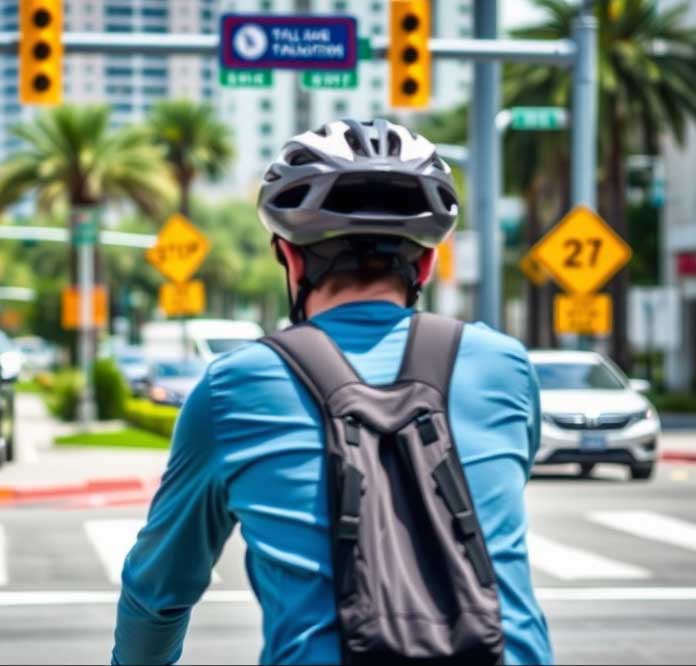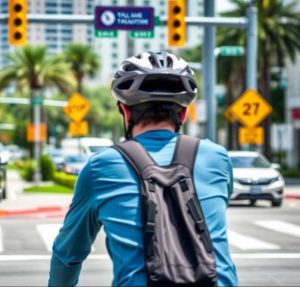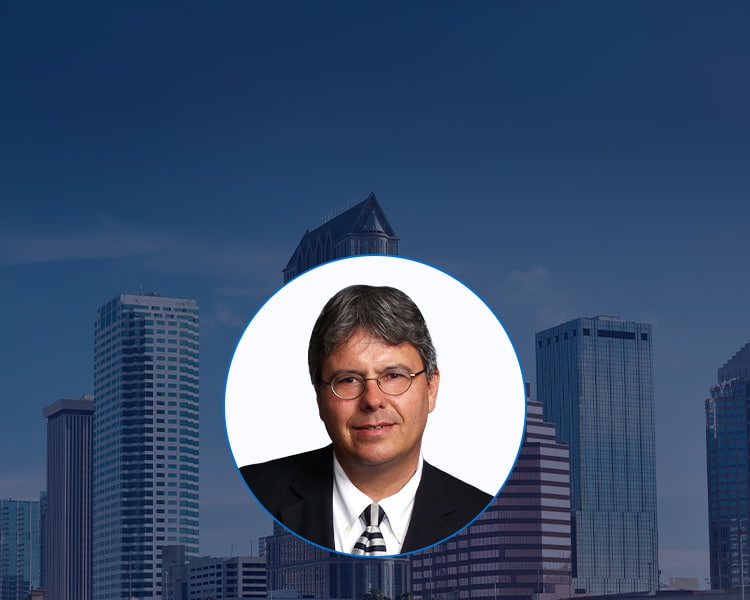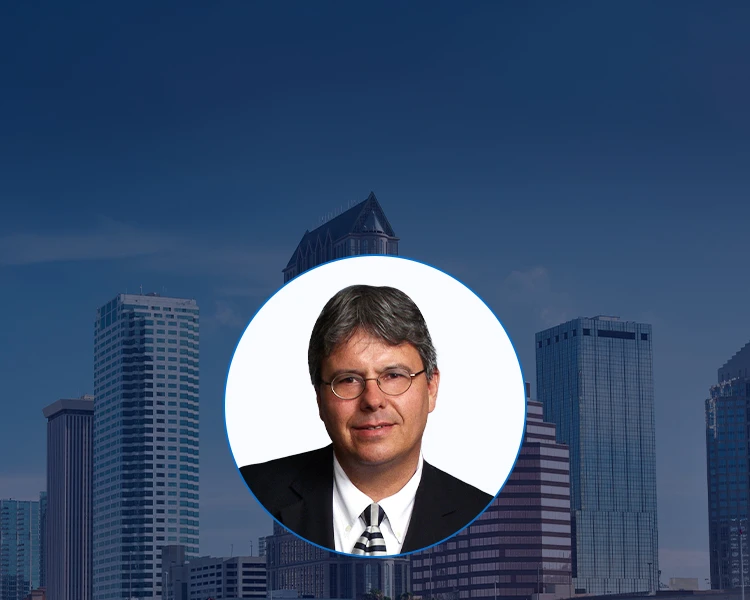- Free Consultation: (813) 222-2220 Tap Here to Call Us
Bicycle Accidents in Florida


Navigating the Danger: Bicycle Accident Safety in Tampa Bay’s Troubled Intersections
Florida, with its year-round sunshine and flat terrain, should be a cyclist’s paradise. Yet, the reality is far from idyllic, particularly in the bustling Tampa Bay region. From the sun-soaked streets of St. Petersburg to the busy boulevards of Tampa, cyclists face a daily gauntlet of risks. This post delves into the alarming trends, specific bicycle accident hotspots, and the urgent need for improved safety measures across Pinellas and Hillsborough counties.

Are eBikes dangerous? Electric bike riders are seeing a wave of bicycle accidents, highlighting the importance of safety standards. If you’ve been injured in an eBike accident, protect your rights. Call Casey the Lawyer today at 813-222-2220 for a free consultation.
The Alarming Statistics: Florida’s Perilous Pedaling
Florida consistently ranks among the most dangerous states for cyclists in the United States. The Florida Department of Highway Safety and Motor Vehicles (FLHSMV) data paints a grim picture, with a consistently high number of bicycle accidents and fatalities. Factors such as increased bicycle usage, high traffic volume, distracted driving, and a lack of dedicated bike lanes contribute to this alarming trend.
The Tampa Bay area, with its blend of urban density and tourist traffic, magnifies these risks. Pinellas County, in particular, has emerged as a hotspot for cyclist fatalities, drawing attention from local news outlets like the Tampa Bay Times. Reports highlight a disturbing rise in cyclist deaths, with numbers climbing in recent years. This trend underscores the urgent need for action.
Pinellas County: A Hotbed of Hazards
Pinellas County’s reputation as a dangerous place for cyclists is well-earned. The county’s dense population and busy roadways create a challenging environment for those on two wheels. Several factors contribute to bicycle accidents:
- Inadequate Infrastructure: Many roads lack dedicated bike lanes, forcing cyclists to share space with high-speed vehicles. Dangerous intersections, marked by poor visibility and complex traffic patterns, further exacerbate the risks.
- High Traffic Volume: The county’s population density means congested roads, increasing the likelihood of collisions.
- Visibility and Lighting: Poor lighting, especially at night, makes it difficult for drivers to see cyclists.
Specific intersections and roadways have become notorious for accidents:
- U.S. 19: This major highway, with its high-speed traffic, presents a significant danger to cyclists. Intersections like those with Drew Street and Gulf-to-Bay Boulevard are particularly hazardous.
- 38th Avenue North: This east-west corridor, especially its intersection with U.S. 19, is another accident hotspot.
- Gulf-to-Bay Boulevard: This busy thoroughfare and its intersections, especially with U.S. 19, are known for chaotic traffic patterns.
- 66th Street: This road has a high volume of accidents, and the intersection with 22nd Avenue North is very dangerous.
News reports often detail tragic incidents at these locations, highlighting the human cost of these infrastructure shortcomings.
Hillsborough County: Navigating Urban Chaos
Hillsborough County, with its urban core in Tampa, presents its own set of challenges. The high volume of traffic, particularly around the University of South Florida (USF), creates a dangerous environment for cyclists.
Key areas of bicycle accident concern include:
- Bruce B. Downs Boulevard: This corridor, especially near USF, is notorious for high crash rates. The section between 138th and Bearss Avenue and intersections like those with Fletcher Avenue are particularly problematic.
- Waters Avenue: Intersections along Waters Avenue, such as those with Hanley Road and Himes Avenue, are known for high crash rates.
- Hillsborough Avenue: The intersection with Sheldon Road is another area of concern.
- Areas near USF: The high density of students and traffic makes this area particularly hazardous.
Factors contributing to these dangers include:
- High Traffic Volume: Tampa’s urban congestion increases the risk of collisions.
- Distracted Driving: Distracted driving is a major factor in many accidents.
- Infrastructure Challenges: While improvements are being made, some areas still lack adequate bike lanes.
- Pedestrian and Cyclist Congestion: Especially around USF, the combination of pedestrians, cyclists, and vehicles creates a dangerous mix.
Dangerous Intersections: A Closer Look at Bicycle Accidents
To better understand the risks, let’s examine some of the most dangerous intersections, the types of accidents that are likely to occur there, and the counties they’re located in:
| Intersection | County | Likely Accident Types |
| Bruce B. Downs Blvd & E 138th Ave | Hillsborough | Rear-end collisions, T-bone accidents (due to high-speed traffic and lane changes), pedestrian/cyclist collisions |
| Bruce B. Downs Blvd & E Fletcher Ave | Hillsborough | Similar to above, plus increased risk of turning conflicts due to higher pedestrian and cyclist volume |
| W Waters Ave & Hanley Rd | Hillsborough | Rear-end collisions, angle collisions (due to turning traffic), potential for head-on collisions |
| W Waters Ave & N Himes Ave | Hillsborough | Similar to above, with added risk due to commercial area and potential for distracted driving |
| Sheldon Rd & W Hillsborough Ave | Hillsborough | High-speed rear-end and T-bone collisions, turning conflicts |
| USF Area (various intersections) | Hillsborough | A mix of all the above, with increased pedestrian and cyclist interactions |
| US-19 ALT & Drew St | Pinellas | High-speed rear-end and T-bone collisions, potential for head-on collisions |
| US-19 & Gulf-to-Bay Blvd | Pinellas | Similar to above, with added complexity due to intersection layout and traffic volume |
| US-19 & 38th Ave N | Pinellas | High-speed collisions, turning conflicts, pedestrian/cyclist collisions |
| 38th Ave N & 4th St N | Pinellas | Similar to above, with potential for increased pedestrian and cyclist interactions |
| 66th St N & 22nd Ave N | Pinellas | High-speed collisions, turning conflicts, potential for limited visibility issues |
Important Notes:
- This table is based on general observations and trends, not specific accident data.
- The “Likely Accident Types” are estimations based on the characteristics of each intersection.
- Actual accident data may vary.
To get more precise information on accident types at these intersections, you would need to consult official crash reports from local authorities or the FLHSMV.
The Tampa Bay Times: Shedding Light on the Issue
Local news outlets, particularly the Tampa Bay Times, play a crucial role in raising awareness about bicycle safety. Their reporting on specific accidents, dangerous intersections, and safety initiatives helps to keep the issue in the public eye.
The Tampa Bay Times has consistently highlighted the high rates of cyclist fatalities in Pinellas County, particularly in St. Petersburg. They have also drawn attention to the dangers of specific roadways and intersections, providing valuable information to cyclists and drivers alike.
The Need for Action: Improving Bicycle Safety
Addressing the issue of bicycle safety requires a multi-faceted approach:
- Infrastructure Improvements: Investing in dedicated bike lanes, protected intersections, and improved lighting is essential.
- Driver Education: Raising awareness about bicycle safety and promoting responsible driving habits is crucial.
- Enforcement: Enforcing traffic laws and holding distracted drivers accountable can help to reduce accidents.
- Community Engagement: Encouraging community involvement in bicycle safety initiatives can help to create a culture of safety.
Frequently Asked Bicycle Accident Questions
The most common causes include distracted driving, failure to yield to cyclists, unsafe lane changes, and inadequate bicycle infrastructure.
Always wear a helmet, use lights and reflectors (especially at night), obey traffic laws, be aware of your surroundings, and try to avoid the most dangerous intersections during peak traffic hours.
ey improvements include investing in dedicated bike lanes, protected intersections, better lighting, increased driver education, and stricter enforcement of traffic laws.
You can find more information from the FLHSMV, local law enforcement agencies, and local news sources like the Tampa Bay Times.
Bicycle Accident Summary:
The safety of cyclists in the Tampa Bay area is a pressing issue that demands immediate attention. By addressing infrastructure shortcomings, promoting driver education, and fostering a culture of safety, we can work towards creating a safer environment for all cyclists. It is important for drivers and cyclists alike to remain vigilant, and share the road. By doing so, we can prevent the tragic loss of life, and injury that currently plagues the roads of the Tampa bay area.
If you’ve been injured in an eBike accident, protect your rights. Call Casey the Lawyer today at 813-222-2220 for a free consultation.



